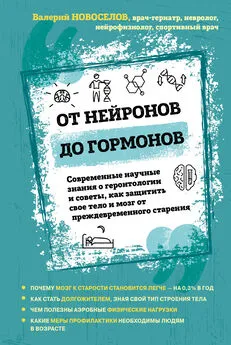Бастиан Блоэм - Нестареющее тело. Научное исследование о том, как защитить свои тело и мозг и не допустить развития неврологических заболеваний
- Название:Нестареющее тело. Научное исследование о том, как защитить свои тело и мозг и не допустить развития неврологических заболеваний
- Автор:
- Жанр:
- Издательство:Эксмо
- Год:2021
- Город:Москва
- ISBN:978-5-04-155994-6
- Рейтинг:
- Избранное:Добавить в избранное
-
Отзывы:
-
Ваша оценка:
Бастиан Блоэм - Нестареющее тело. Научное исследование о том, как защитить свои тело и мозг и не допустить развития неврологических заболеваний краткое содержание
Нестареющее тело. Научное исследование о том, как защитить свои тело и мозг и не допустить развития неврологических заболеваний - читать онлайн бесплатно ознакомительный отрывок
Интервал:
Закладка:
92. Parkinson J. An essay on the shaking palsy. Journal of Neuropsychiatry and Clinical Neurosciences. 2002;14(2):223–236.
93. Braak H, Del Tredici K, Rub U, de Vos RAI, Jansen Steur ENH, Braak E. Staging of brain pathology related to sporadic Parkinson’s disease. Neurobiology of Aging. 2003;24(2):197–211; Braak H, Rub U, Gai WP, Del Tredici K. Idiopathic Parkinson’s disease: possible routes by which vulnerable neuronal types may be subject to neuroinvasion by an unknown pathogen. Journal of Neural Transmission. 2003;110(5):517–536.
94. Braak H, Rub U, Gai WP, Del Tredici K. Idiopathic Parkinson’s disease: possible routes by which vulnerable neuronal types may be subject to neuroinvasion by an unknown pathogen. Journal of Neural Transmission . 2003;110(5):517–536.
95. Silva BA, Einarsdottir O, Fink AL, Uversky VN. Biophysical characterization of a-synuclein and rotenone interaction. Biomolecules. 2013;3(3):703–732.
96. Del Tredici K, Hawkes CH, Ghebremedhin E, Braak H. Lewy pathology in the submandibular gland of individuals with incidental Lewy body disease and sporadic Parkinson’s disease. Acta Neuropathologica. 2010;119(6):703–713; Del Tredici K, Braak H. Spinal cord lesions in sporadic Parkinson’s disease. Acta Neuropathologica . 2012;124(5):643–664.
97. Breen DP, Halliday GM, Lang AE. Gut-brain axis and the spread of a-synuclein pathology: vagal highway or dead end? Movement Disorders . 2019;34(3):307–316.
98. Braak H, Rub U, Gai WP, Del Tredici K. Idiopathic Parkinson’s disease: possible routes by which vulnerable neuronal types may be subject to neuroinvasion by an unknown pathogen. Journal of Neural Transmission . 2003;110(5):517–536.
99. Pan-Montojo F, Anichtchik O, Dening Y, et al. Progression of Parkinson’s disease pathology is reproduced by intragastric administration of rotenone in mice. PLOS ONE. 2010;5(1):e8762; Holmqvist S, Chutna O, Bousset L, et al. Direct evidence of Parkinson pathology spread from the gastrointestinal tract to the brain in rats. Acta Neuropathologica . 2014;128(6):805–820.
100. Braak H, Del Tredici K, Rub U, de Vos RAI, Jansen Steur ENH, Braak E. Staging of brain pathology related to sporadic Parkinson’s disease. Neurobiology of Aging. 2003;24(2):197–211.
101. Stokholm MG, Danielsen EH, Hamilton-Dutoit SJ, Borghammer P. Pathological a-synuclein in gastrointestinal tissues from prodromal Parkinson disease patients. Annals of Neurology. 2016;79(6):940–949; Ross GW, Abbott RD, Petrovitch H, et al. Association of olfactory dysfunction with incidental Lewy bodies. Movement Disorders. 2006;21(12):2062–2067.
102. Chaudhuri KR, Healy DG, Schapira AHV. Non-motor symptoms
of Parkinson’s disease: diagnosis and management. Lancet Neurology . 2006;5(3):235–245; Winge K, Skau A-M, Stimpel H, Nielsen KK, Werdelin L. Prevalence of bladder dysfunction in Parkinsons disease. Neurourology and Urodynamics. 2006;25(2):116–122; Aarsland
D, Andersen K, Larsen JP, Lolk A. Prevalence and characteristics of dementia in Parkinson disease: an 8-year prospective study. Archives of Neurology. 2003;60(3):387–392; Hely MA, Reid WGJ, Adena MA, Halliday GM, Morris JGL. The Sydney multicenter study of Parkinson’s disease: the inevitability of dementia at 20 years. Movement Disorders . 2008;23(6):837–844.
103. Svensson E, Horvath-Puho E, Thomsen RW, et al. Vagotomy and subsequent risk of Parkinson’s disease. Annals of Neurology. 2015;78(4):522–529.
Глава 2: Рукотворная пандемия
1. Parkinson’s: an industrial age disease [стенограмма]. Living on Earth. August 15, 1997. www.loe.org/shows/segments.html?programID=97-P13-00033&segmentID=1. Accessed March 26, 2019.
2. Poskanzer DC, Schwab RS. Studies in the epidemiology of Parkinson’s disease predicting its disappearance as a major clinical entity by 1980. Transactions of the American Neurological Association . 1961;86:234–235.
3. Constantin von Economo. Wikipedia. https://en.wikipedia.org/ wiki/Constantin_von_ Economo. Accessed February 15, 2019; Sak J, Grzybowski A. Brain and aviation: on the 80th anniversary of Constantin von Economo’s (1876–1931) death. Neurological Sciences. 2013;34(3):387–391.
4. Dickman MS. von Economo encephalitis. Archives of Neurology. 2001;58(10):1696–1698.
5. Lutters B, Foley P, Koehler PJ. The centennial lesson of encephalitis lethargica. Neurology. 2018;90(12):563–567.
6. Vilensky JA, Hoffman LA. Encephalitis lethargica: 100 years after the epidemic. Brain. 2017;140(8):2246–2251.
7. Sak J, Grzybowski A. Brain and aviation: on the 80th anniversary of Constantin von Economo’s (1876–1931) death. Neurological Sciences. 2013;34(3):387–391; Dickman MS. von Economo encephalitis. Archives of Neurology. 2001;58(10):1696–1698; Estupinan D, Nathoo S, Okun MS. The demise of Poskanzer and Schwab’s influenza theory on the pathogenesis of Parkinson’s disease. Parkinson’s Disease. 2013;2013:167843.
8. Lutters B, Foley P, Koehler PJ. The centennial lesson of encephalitis lethargica. Neurology. 2018;90(12):563–567.
9. Sacks O. Awakenings. Rpt. ed. Vintage; 1999./ Оливер Сакс «Пробуждения»
10. Там же.
11. Там же.
12. Там же.
13. Poskanzer DC, Schwab RS. Studies in the epidemiology of Parkinson’s disease predicting its disappearance as a major clinical entity by 1980. Transactions of the American Neurological Association. 1961;86:234–235.
14. The Parkinson’s puzzle. Time . 1974;104:71.
15. Moore G. Influenza and Parkinson’s disease. Public Health Reports. 1977;92(1):79–80.
16. Hoehn MM. Age distribution of patients with Parkinsonism. Journal of the American Geriatrics Society. 1976;24(2):79–85.
17. Margaret “Peggy” Hoehn M.D. Denver Post. July 22, 2005;Obituary.
18. GBD 2016 Parkinson’s Disease Collaborators. Global, regional, and national burden of Parkinson’s disease, 1990–2016: a systematic analysis for the Global Burden of Disease Study 2016. Lancet Neurology. 2018;17(11):939–953.
19. Muangpaisan W, Hori H, Brayne C. Systematic review of the prevalence and incidence of Parkinson’s disease in Asia. Journal of Epidemiology . 2009;19(6):281–293.
20. Goldman SM. Environmental toxins and Parkinson’s disease. Annual Review of Pharmacology and Toxicology. 2014;54(1):141–164.
21. Tilman D, Cassman KG, Matson PA, Naylor R, Polasky S. Agricultural sustainability and intensive production practices. Nature. 2002;418:671–677.
22. FAOSTAT: pesticides. Food and Agriculture Organization of the United Nations. www.fao.org/faostat/en/#data/EP/visualize. Accessed February 15, 2019.
23. Там же.
24. Tilman D, Cassman KG, Matson PA, Naylor R, Polasky S. Agricultural sustainability and intensive production practices. Nature . 2002;418:671–677.
25. Rutchik JS. Organic solvent neurotoxicity. Medscape. https://emedicine. medscape.com/ article/1174981-overview. Updated December 11, 2018. Accessed February 15, 2019.
26. Solvents. ChemicalSafetyFacts.org. www.chemicalsafetyfacts.org/ solvents. Accessed March 26, 2019.
27. Dick FD. Solvent neurotoxicity. Occupational and Environmental Medicine. 2006;63(3):221–226.
28. C2 chlorinated solvents. IHS Markit. October 2017. https://ihsmarkit. com/products/c2-chlorinated-chemical-economics-handbook.html. Accessed March 26, 2019.
29. Ritz B, Lee P-C, Hansen J, et al. Traffic-related air pollution and Parkinson’s disease in Denmark: a case-control study. Environmental Health Perspectives. 2016;124(3):351–356; Doty RL. Olfactory
dysfunction in Parkinson disease. Nature Reviews Neurology. 2012;8:329–339; Calderon-Garciduenas L, Azzarelli B, Acuna H, et al. Air pollution and brain damage. Toxicologic Pathology . 2002;30(3):373–389.
30. GBD 2016 Parkinson’s Disease Collaborators. Global, regional, and national burden of Parkinson’s disease, 1990–2016: a systematic analysis for the Global Burden of Disease Study 2016. Lancet Neurology. 2018;17(11):939–953.
31. Rocheleau M. Chart: the percentage of women and men in each profession. Boston Globe. March 6, 2017. www.bostonglobe.com/ metro/2017/03/06/chart-the-percentage-women-and-men-each-profession/GBX22YsWl0XaeHghwXfE4H/story.html. Accessed February 15, 2019.
32. GBD 2016 Parkinson’s Disease Collaborators. Global, regional, and national burden of Parkinson’s disease, 1990–2016: a systematic analysis for the Global Burden of Disease Study 2016. Lancet Neurology. 2018;17(11):939–953; Van Den Eeden SK, Tanner CM, Bernstein AL, et al. Incidence of Parkinson’s disease: variation by age, gender, and race/ ethnicity. American Journal of Epidemiology. 2003; 157(11): 10151022; Wooten GF, Currie LJ, Bovbjerg VE, Lee JK, Patrie J. Are men at greater risk for Parkinson’s disease than women? Journal of Neurology, Neurosurgery & Psychiatry. 2004;75(4):637–639; Mayeux R, Marder K, Cote LJ, et al. The frequency of idiopathic Parkinson’s disease by age, ethnic group, and sex in northern Manhattan, 1988–1993. American Journal of Epidemiology. 1995;142(8):820–827.
33. Roser M. Life expectancy. Our World in Data. https://ourworldindata. org/life-expectancy. Accessed March 31, 2019.
34. Там же.
35. Paid notice: Deaths: Hoehn, Professor Margaret “Peggy,” M.D. New York Times. July 24, 2005: 1001032.
36. International programs: International Data Base. US Census Bureau. www.census.gov/data-tools/demo/idb/informationGateway.php. Updated: September 2018. Accessed November 19, 2018; Population ages 65 and above, total. World Bank. https://data.worldbank.org/indicator/ SP.POP.65UP.To. Accessed November 19, 2018.
37. Levy G. The relationship of Parkinson disease with aging. Archives of Neurology . 2007;64(9):1242–1246.
38. Savica R, Rocca WA, Ahlskog JE. When does Parkinson disease start? Archives of Neurology. 2010;67(7):798–801.
39. Van Den Eeden SK, Tanner CM, Bernstein AL, et al. Incidence of Parkinson’s disease: variation by age, gender, and race/ethnicity. American Journal of Epidemiology. 2003;157(11):1015–1022. www.ncbi. nlm.nih.gov/pubmed/12777365.
40. Scutti S. Drug overdoses, suicides cause drop in 2017 US life expectancy; CDC director calls it a “wakeup call.” CNN. December 17, 2018. www.cnn. com/2018/11/29/health/life-expectancy-2017-cdc/index.html. Accessed February 15, 2019; Naik G. Global life expectancy increases by about six years: study in Lancet says rise is results of dramatic health-care advances. Wall Street Journal. December 18, 2014; Murray CJL, Barber RM, Foreman KJ, et al. Global, regional, and national disability-adjusted life
years (DALYs) for 306 diseases and injuries and healthy life expectancy (HALE) for 188 countries, 1990–2013: quantifying the epidemiological transition. The Lancet. 2015;386(10009):2145–2191.
41. Wanneveich M, Moisan F, Jacqmin-Gadda H, Elbaz A, Joly P. Projections of prevalence, lifetime risk, and life expectancy of Parkinson’s disease (2010–2030) in France. Movement Disorders. 2018;33(9):1449–1455.
42. Proctor RN. The history of the discovery of the cigarette-lung cancer link: evidentiary traditions, corporate denial, global toll. Tobacco Control. 2012;21(2):87–91.
Читать дальшеИнтервал:
Закладка:






